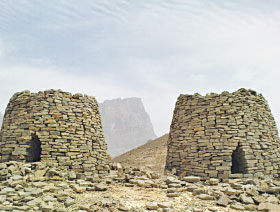Among the recent discoveries at Bat, the ancient civilisation site, another major find are new honey comb tombs.

Excavation is going on in the area to find out more about the archaeological sites and the Omani traditional civilisation.
Discoveries
Archaeologists are currently focusing on the ancient cemetery found there, which lies some 30km from the modern Ibri.
More than a hundred tombs built of solid stone and other tombs were unearthed in the southern parts of the cemetery, which resemble those found in the Umm Al Nar tombs.
The Bat archeological site contains a hundred stone tombs, which all show signs of being more advanced than the ‘beehive tombs’, but less developed than the Umm Al Nar tombs. The ‘beehive tombs’ contain between two and five graves, while the latter type — 20 of which were found — are communal graves. In both types of tombs, the pieces of red pottery found were similar to the ‘Jumdat Nasr’ pottery in Iraq.
The other discoveries included high-grade red pottery decorated with black lines and items that appear to be ‘framed’ and designed to be hung. Objects of this type were common in the settlements and tombs of the Umm Al Nar civilisation in the region and neighbouring areas.
Another discovery in Bat was a round structure surrounded by a wall of square-cut rocks. A ‘mint’ was found on the south-eastern side of its entrance.
The archaeologists also discovered a well that divided the building into two halves. Each half contained a row of rectangular rooms without entrances or connecting passages or connections with the outer wall. This suggested that the rooms were not designed for living or accommodation.
After exhaustive archaeological study, it was concluded that these structures – the six rooms – performed the function of watch-towers for the area.
However, Bat and other archaeological and tourist destinations in the wilayat of Ibri can have better tourism promotion schemes and can be developed more like other tourist sites across the Sultanate.
In Bat, the tomb fences have almost collapsed and even some livestock can be found inside these tombs, say villagers.
Ahmed Al Muqbali, a resident of Bat, said that the authorities concerned should protect this ancient archeological site by building new fences and provide it with the necessary services like guarding of the site, and a small museum showcasing the history of these tombs.
Author: Fahad Al Mukrashi | Source: Times of Oman [August 11, 2011]